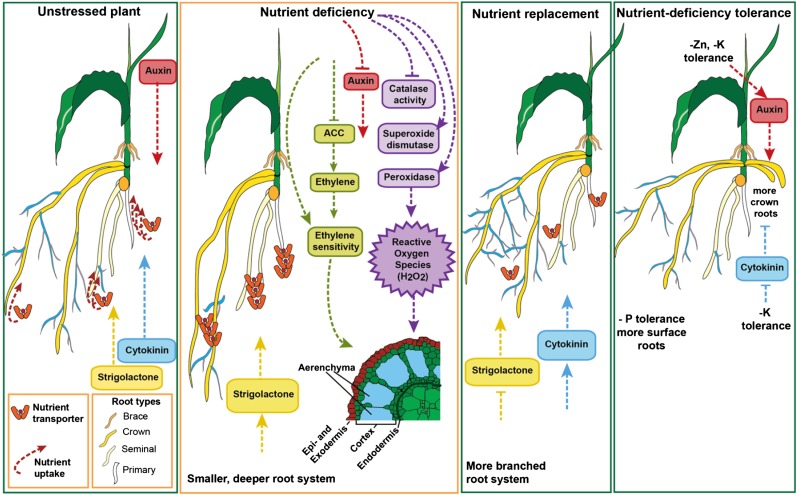Figure 3.
Nutrient responses in adventitious roots. Under nutrient-replete conditions, crown roots have the lowest nutrient uptake rates, followed by seminal roots, while the primary roots have the highest uptake. When nutrients are deficient, the expression of nutrient transporters increases. In addition, strigolactone increases while auxin decreases, resulting in long roots with minimal lateral roots. Reactive oxygen species increase via changes in antioxidant enzyme activity (catalase, superoxide dismutase, and peroxidase) and, together with enhanced ethylene sensitivity, trigger lysigenous aerenchyma formation. When nutrients are replaced, nutrient transporter expression decreases systemically, cytokinin production increases, strigolactone levels decrease, and lateral root initiation increases on the adventitious roots. In potassium and zinc deficiency-tolerant lines, auxin signaling increases, and in potassium-efficient lines, cytokinin signaling decreases, together resulting in more adventitious roots. In phosphorus-efficient lines, more adventitious roots are found in the surface layers of the soil. In the cross section, epidermis and exodermis are combined, but the exodermis can be several cell layers adjacent to the epidermis. Pointed arrows represent positive interactions, and flat-ended arrows represent negative interactions. –K, Potassium deficiency; –P, phosphorus deficiency; –Zn = zinc deficiency. Yellow roots are crown roots, orange roots (the upper, short ones here) are brace roots (both adventitious root types), cream roots are seminal roots, white roots are primary roots, and blue and pink roots are lateral roots. ACC, 1-Aminocyclopropane-1-carboxylic acid (an ethylene precursor).

